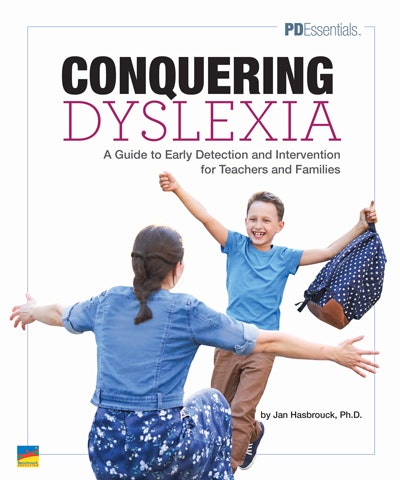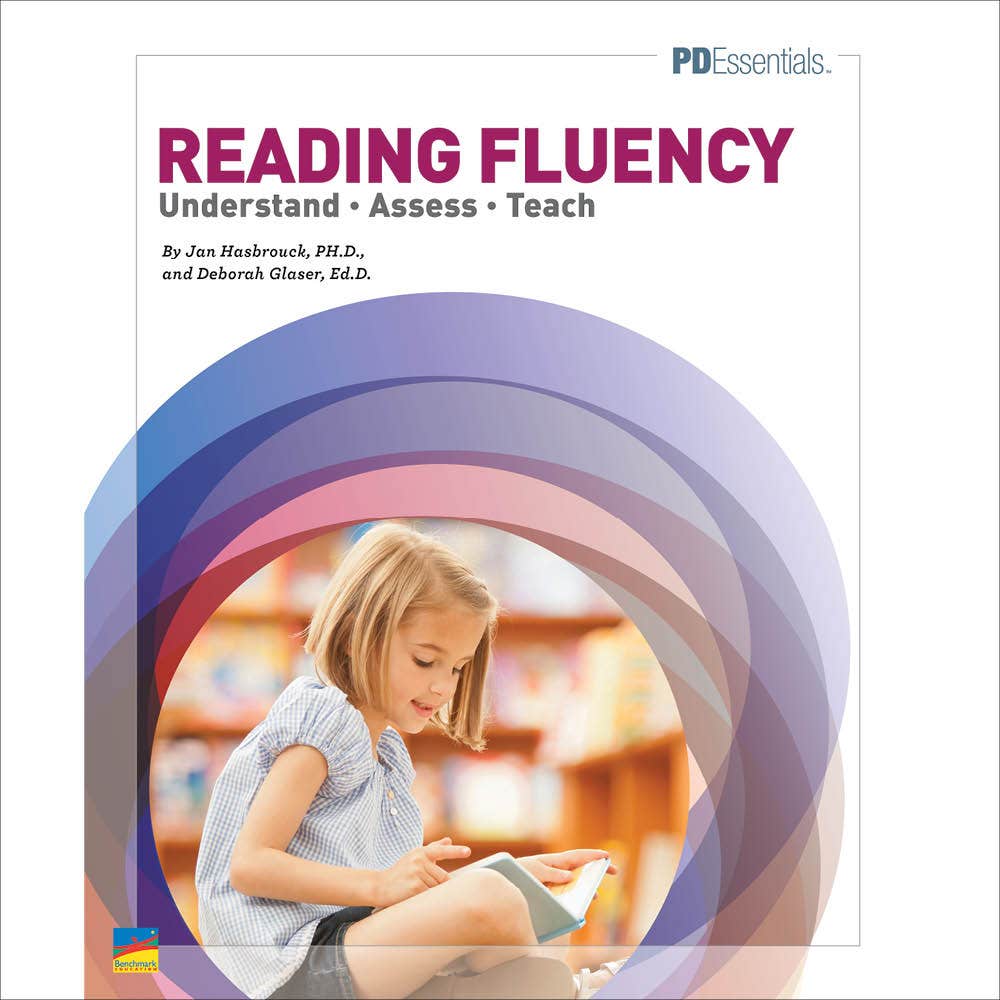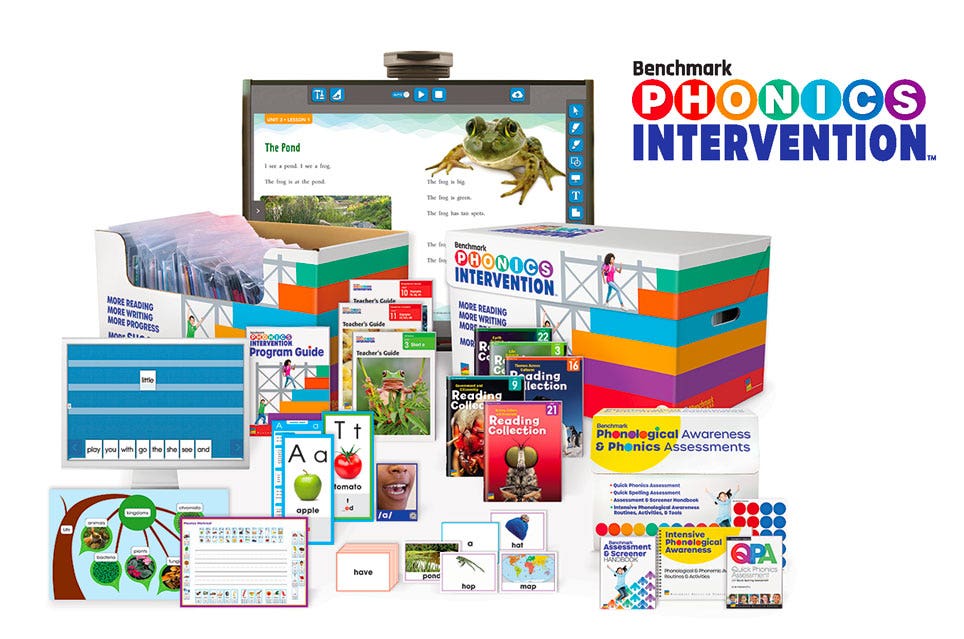- Benchmark Education
- Newmark Learning
- Reycraft Books
- Create an Account
About the Experts

Jan Hasbrouck, Ph.D.
Jan Hasbrouck, Ph.D., is an educational consultant, author, and researcher who earned her B.A. and M.A. from the University of Oregon and completed her Ph.D. at Texas A&M University. Her research on reading assessment, coaching, and second language learners has been published in numerous professional books and journals.
Featured Products

Conquering Dyslexia: A Guide to Early Detection and Intervention for Teachers and Families Professional Development Book
In Conquering Dyslexia, Dr. Hasbrouck shares the instructional approaches that work best for children who have this disorder, and the most current information for parents so they can advocate for their children and communicate with educators effectively.
Learn More
Reading Fluency: Understand – Assess – Teach Professional Development Book
Jan Hasbrouck, Ph.D. and Deborah Glaser, Ed.D. have written an accessible and thoughtful resource to help teachers understand the complex, essential, and often misunderstood skill of reading fluency.
Learn More
Benchmark Phonics Intervention
Based on the latest Science of Reading research, Benchmark Phonics Intervention aligns with the tenets of Structured Literacy, shown to be beneficial for students with dyslexia and other learning disabilities.
Learn MoreEpisode Transcript
Announcer: This podcast is produced by Benchmark Education.
Kevin Carlson: In this episode of Teachers Talk Shop — The Science of Dyslexia. I'm Kevin Carlson, and this is Teachers Talk Shop.
Dr. Jan Hasbrouck: We know now so much more about what this thing is called dyslexia. We do know that early identification and early intervention is so important.
Kevin Carlson: That is Dr. Jan Hasbrouck. She is an educational consultant and author whose research in areas of reading assessment, coaching, and second-language learners has been published in numerous professional books and journals. In fact, she is the author of Conquering Dyslexia: A Guide to Early Detection and Intervention for Teachers and Families, a book from Benchmark Education's PD Essentials line. While the research on dyslexia is still evolving, much of it is solid and clear. Dr. Hasbrouck's experience with it is both professional and personal. Recently, author and educator Patty McGee spoke with her about that research, some myths around dyslexia, and the need for strong systematic phonics instruction to help students with dyslexia. Here is Patti with Dr. Jan Hasbrouck.
Patty McGee: Jan, thank you so much for joining us today.
Dr. Jan Hasbrouck: My pleasure, Patty.
Patty McGee: Maybe you could start with the importance of foundational skills and dyslexia.
Dr. Jan Hasbrouck: Well, yes, just that term, “foundational,” kind of says it all, doesn't it? Those skills that we think about—and there could be some professionals here who specialize in that, either as practitioners or researchers, there might be some nuanced discussion about that—but in general, there's a lot of evidence around the certain components around phoneme awareness and phonics and how those two things need to work together to help our students learn words that then move into contexts that we feed in their language and their background, and their knowledge of grammar and syntax and semantics and vocabulary, and we want to pull all of that together. We can think about the amazing Scarborough's Rope as a visual, pulling all those things in and weaving them tightly to fluent reading that we hope has motivation for students, too, that they love to read at the end of all this process. That's not something we have a whole lot of control, but we do—we do have a lot. We as practitioners, as educators, have a lot of control about how our students acquire those foundational skills. And there's a certain number of children, we don't know the exact number—there's theories around 50, 60% of children—with minimal guidance and instruction who are going to acquire those essential foundational skills so they can get launched in reading and do all the wonderful stuff that we know is ahead of them, because they'll be readers.
But that leaves 50%, 40% or so who are going to need more from us—more thoughtful, planned instruction, not just activities, but thoughtful instruction around those foundational skills. So we don't, and we never will, have the exact number or proportion of the population that we would call dyslexic. Probably somewhere between 5 to 10% of children's brains are born with a particular anomaly in their brain that makes processing certain aspects of language difficult. And because of that anomaly, acquiring those foundational skills, or at least some of those foundational skills, is particularly difficult. That's a fact. It's a sort of nuanced fact, but no matter what that number is—and some people take it up to perhaps as much as 20% of the population—that's a significant number of children that we need to be aware of in our classrooms, in our schools, in our preschool settings. That's an important consideration, too, because we know now so much more about what this thing is, called dyslexia. And we do know that early identification and early intervention is so important. So yeah, those foundational skills and dyslexia are very important for all of us to be thinking about.
Kevin Carlson: After the break. Some myths around dyslexia. Stay with us.
Announcer: There is a new resource for families and teachers confronting dyslexia: Conquering Dyslexia by Dr. Jan Hasbrouck. In it, she shares the instructional approaches that work best and the most current information for parents, so they can advocate for their children and communicate effectively with educators.
Dr. Jan Hasbrouck: I have two children, one of whom has dyslexia. I understand the difficulties that dyslexia presents around reading, writing, and spelling. I do hope that Conquering Dyslexia will be helpful to you, whatever role you play with a child with dyslexia.
Announcer: Conquering Dyslexia is available now at PD Essentials dot com. Go teach brilliantly.
Patty McGee: I've heard you talk about… dyslexia is hard for any student, and there are ways to make it easier, and there are ways that we can pretty much set up for this to be harder than it needs to be. So can you speak a little bit to that?
Dr. Jan Hasbrouck: What we've honed in on, I think—and the research is still coming, I attended a webinar last Friday from someone who's doing research in the role of visual processors with children with dyslexia. I don't think there's anybody anymore that believes that dyslexia is a visual problem. It's where we started over 100 years ago. That was the theory, because we didn't have all these abilities to look at the brain and how it's functioning. So we've honed in on the way brains process auditory aspects of spoken language. And it's the spoken language that's translated into print for most of us. If you're blind, then we're going to use a different symbol system. But for most of us, the symbolic representation of spoken language is print. And for the most part, our students with dyslexia don't have any problem with the visual aspects. It's the auditory. So where we make it easier for children—and again, starting as early as possible—there are things, appropriate things that we can be doing with three-year-olds and four-year-olds to help activate and support the activity of the brain that does that auditory processing of sounds. And for a three or a four-year old, that would be a very game-like activity. All those wonderful things that parents kind of do naturally, of reading rhymes and stories, nursery rhymes, and those kinds of things, and playing word games with their young children—that can all be very helpful, because those are foundational skills to the foundation of reading and once we get them in kindergarten, we can really start doing more systematic and explicit instruction.
But focusing in on that aspect while we're still doing all the things we should do for every reader—which is that background knowledge and the vocabulary and talking to the children, stimulating their language—most children with dyslexia don't have any problem with those kinds of things and should be completely immersed and stimulated and provided all the opportunities in the language part. It's just sort of mind boggling about what that anomaly is like. Because they hear language, but it's getting down to the individual phoneme, the sound, the individual sound in a word—like we take the word “mud,” which has three different sounds in it, we don't even need to think about that very often, unless maybe we're spelling it. But that's the problem that our children with dyslexia have, primarily. They can have extra. Some of these kids are challenged with lots of other things going on. But when parents and teachers suspect that their student, their child, may have those kind of struggles—and parents might think of that because some of their older children may have had problems with that, or they themselves, because we understand often dyslexia runs in families. So if they've got an older child in school who's struggling and they have a two-year-old or a three-year-old at home, that might trigger their thinking about, “What are some things we could do so that we make that child's pathway into school easier?”
Patty McGee: Well, thank you for that. And you mentioned that it's really come to light that dyslexia is not, as 100 years ago we thought, was some type of visual issue. What are some other things that we once thought were true about dyslexia but are not?
Dr. Jan Hasbrouck: Yeah, there are a lot of myths around dyslexia, for sure. And that's probably one of the most pervasive, is that it has something to do with the eye. As long as we've had print and reading, there were probably people noticing that this learning-to-read print was very easy for some and not for others. But the first description in print about a particular problem with learning to read that we would now call dyslexia, they labeled that as “word blindness.” It was described as in this one individual that they could do everything else just perfectly well—they could speak, they could function in society, they had no issues. But when it came to trying to read words, they couldn't seem to see the words. One of the mythologies that has hung around from that has to do with the manifestation of difficulties with letters. And people will say, “Kids with dyslexia reverse letters, they can't see a B and a D, and they get them mixed up, or even a P and a Q or some of the other similar letters, that they see them differently, they write them differently, and that that's a sign of dyslexia.”
And what we know is that anybody who's ever taught kindergarten, first, second grade and maybe some of the other grades knows that, yeah, some kids do that. You show them, “Oh, no, no, honey, this is a B and this is a D.” And they go, “Okay.” And then they do it all over again. So we know children do that. What we've come to understand, however, is that is not a sign of dyslexia. A lot of kids do that. Figuring out that B and D and P and Q are different things is really confusing to a whole lot of kids. There's really only a few kids that get that right away. So it's a developmental thing. It's not a sign of dyslexia. However, if children continue to have that problem on into second grade and third grade—again, it's not a guaranteed sign that that child has dyslexia. But children who do have dyslexia because of the struggle that their brain is having, trying to make sense of print and what is the sound and what is that image?—their brains have difficulty making sense of that. So when you see that in older students it may be a red flag. Hopefully there were red flags much earlier than that, but especially early on, we would not say that those reversals or backwards writing or all the kinds of manifestations are particularly associated or indicators of dyslexia. So that's common. Really common. Still I hear people saying that.
Patty McGee: So you wrote the book Conquering Dyslexia, which has really become a pivotal book for so many to read. And I know personally from experience in writing books that once I finished writing the book, I learned things afterwards that I wanted to—if I could turn back time, I'd add that into the book. Has that happened with you?
Dr. Jan Hasbrouck: Oh of course. Yes, absolutely. If I write an email, I want to pull it back in.
Patty McGee: True. But specifically with Conquering Dyslexia.
Dr. Jan Hasbrouck: Well, yeah, Patty, thank you for asking that. Yes, of course there are ways that I've written certain sentences and things that I would change particularly, simply because we know a lot about dyslexia, but we're still learning about dyslexia. So I think there are aspects in the book where I said things a little too firmly—“We know these things”—and I think it's much more accurate always in this complex Sciences of Reading that you mentioned that that body of evidence is continuing to grow and evolve. There's nothing in the book, however, that I would say I got totally wrong and we need to change.
Patty McGee: No, no, no, I wasn't thinking that either.
Dr. Jan Hasbrouck: It's more nuanced. Like that webinar I attended on Friday—I was taking notes about the contribution of visual challenges that some children do have, and some of those children with visual challenges also have dyslexia. How does that manifest and what are some things? And the presenter was saying, it's a very small percentage, we don't know because it's early research, but we've got to be open to those kinds of things. Probably one of the major things I do hope to change in the book is that I did use a visual in there, Nancy Young's Ladder of Reading, and that's what it was when I wrote the book, it was the Ladder of Reading. Nancy, being someone who pays a lot of attention to the evolving body of knowledge developed by researchers, has changed her infographic to be now the Ladder of Reading and Writing, and some of the other aspects about the infographic have changed a little bit, so I would very much like to use her updated version. She does make her infographic available online, so anybody who's interested in the advancements on that infographic can go to her website, Nancy Young dot ca, I think, “ca” being Canada. So that's one of the things that I would like to change. And it would push us all to remember that when we are teaching reading, that writing is the companion of reading. So instructionally, she's definitely moved her that infographic into a correct area. And I did address writing to a certain extent in in the book. In terms of instruction, we need to be teaching reading and writing as companions of each other. Those are some of the things I would address.
Patty McGee: And I think that just by having this conversation, that knowing we're all learning things, as expert as one can be in an area that we're always exploring and searching for, what's another way to expand our thinking and possibility for instruction in the classroom, for students? It's something as professionals we’ll never, ever stop doing, so I appreciate your insights that even add on to the brilliance of Conquering Dyslexia and some new thoughts that you're having since publication.
Kevin Carlson: After the break, Dr. Jan Hasbrouck gets practical. Stay with us.
Announcer: The ultimate purpose of reading is always to comprehend what is being read. In their book, Reading Fluency, Jan Hasbrouck and Deborah Glazer reveal how reading fluency works. Reading Fluency explains the crucial role that fluency plays in proficient reading. It breaks down fluency to its key components and it discusses how the brain processes information. The book includes activities that promote skill integration and looks at different ways to assess students’ fluency skills most effectively.
Dr. Jan Hasbrouck: We know that we can teach almost all children to read proficiently.
Deborah Glazer: We want to help ensure that the act of reading becomes a positive experience for every student.
Announcer: Learn more at PD Essentials dot com. Go teach brilliantly.
Patty McGee: So let's get practical. Can you just share a couple of quick suggestions? Maybe two or three quick suggestions for a teacher who's listening to this, or a school leader who's listening to this and can encourage some of these really clear practices in the classroom?
Dr. Jan Hasbrouck: Oh, I sure would love that opportunity. And I think I will start just by saying that that is really another one of the, uh, when we talk about how to teach our students with dyslexia, that is another one of the pervasive mythologies that is held over for about a hundred years now, that those children need to learn to read and write differently than other children. What we've learned is that that is not true. The more we learn about this incredibly complex process of learning to read, the evidence just keeps coming in that there's really only one way that a brain is going to be reorganized— because that's what has to happen, we reorganize our brains in order to become literate.
What we know about our children with dyslexia is that their brains function a little differently in one aspect of it, but because of what we've learned about the brain, the wonderful neuroplasticity, that we can change brains and we change them through—surgeons can do that—but we know that we as educators can change brains through instruction. The good, powerful, systematic, explicit instruction that everybody's talking about these days is the pathway for almost all children. The difference is a term of dosage and duration. It's just a fact. And we can turn back to Nancy Young's lovely infographic. The whole purpose of the infographic is to demonstrate visually that climbing this ladder, becoming a reader—which is a process for everybody—is very, very, very, almost mysteriously easy for some children. It's relatively easy for others. It's not easy, but it's doable, for others. And then we have our children with dyslexia, for whom it's going to be a bigger process.
But all of those children are going to climb this ladder, learn those foundational skills, associate language with print, know how to decode it and encode it, read it and write it. The process is basically the same. The systematic instruction, we have a plan: Let's… oh, I don't know, let's teach letter-sounds before we ask them to try to read words. That's a good sequence. And within those letter sounds, there's some that are much easier to pronounce and much more useful than others. We're going to get a lot more out of A and M than we are about Q and Z. So that's a systematic decision. Let's teach some things before others. And then the explicitness is to make sure that students know what it is I want them to learn. I show them how to do it, we practice it together, and then they have opportunity to practice it on their own. And it's really there that's the difference for our children with dyslexia, is that the level of explicitness, especially in terms of that dosage and duration of the step of let's practice it together, I'll be right there with you. And this could be in a small group of children, it doesn't have to be one on one. Some of our children with dyslexia are very blessed and very lucky to have the privilege of a tutor, which is often hired by a parent out of their own pocket. And that's done after school situations. But we can take all of that and put it in classrooms.
And I do want teachers to know, and leaders, leadership and administration, that they don't need to go buy a different program. They don't need to train their teachers in a whole different way of teaching. What we want them to know is that good, systematic, explicit, well-designed instruction is going to work for all of their children, no matter where they are on the continuum of ease. But the children with dyslexia are going to need a whole lot more. And that's going to take not only good training and knowledge and support for those teachers, but we have to look at the school day, we have to look at schedules and things like that, because those children are not going to learn. They're going to need more time. They're simply going to need more time and more practice. How are we going to do that? We can't just say, “Okay, no recess, no lunch, no art, no music.” We can't do that. So we do have to work together. We have to meet the needs of all of our children, including our students with dyslexia. And we can. We can do this. There are schools that have figured this out. But it takes a real… good knowledge of what really is involved and a commitment to looking at some of those challenges around time and schedules and all of that.
Patty McGee: Well, Jan, you've given us a lot to think about, and you are reminding us of just the importance of foundational skills, a systematic phonics instructional plan for every student, and how even more essential that is for those who are learning with dyslexia and are also able to do the things that, a lot of times, there have been these myths around that you've shed light on that tell us that, well, we believe this one set of things that just aren't true any longer. And knowing that we have what we need at our fingertips, as long as we make sure that these foundational skills are getting the attention that they need, it's dose and duration, as you were saying.
So thank you for joining us today. Thank you for bringing again your brilliance around teaching and specifically around dyslexia and sharing this with us. It feels like an important conversation to even listen to again and again, to remind us of our direction when it comes to teaching, reading, and to support those who are learning with dyslexia. Thank you.
Dr. Jan Hasbrouck: We need to have a lot of hope around those children because the future is very bright. Yes. For sure.
Kevin Carlson: Thank you, Dr. Jan Hasbrouck. Thank you, Patty McGee, and thank you for listening to Teachers Talk Shop. Jan's book, Conquering Dyslexia, is one of the professional development books used for book study in the Benchmark Phonics Intervention program. Phonics intervention is an intensive Tier 3 phonics intervention program designed for students two or more years below grade level expectations. Lessons are designed to be delivered one-on-one or in small group by an intervention specialist or resource teacher. It is built on the Science of Reading research and aligns to the tenets of Structured Literacy, shown to be beneficial for students with dyslexia. You can learn more about Phonics intervention at Benchmark Education dot com.
Throughout this season, we talk with leading literacy experts to explore current understandings and nuances of teaching and learning literacy. Our aim is to present a 360-degree view of literacy that positions us to address the needs of all students in today's classrooms.
Thanks for listening. For Benchmark education, I'm Kevin Carlson.


